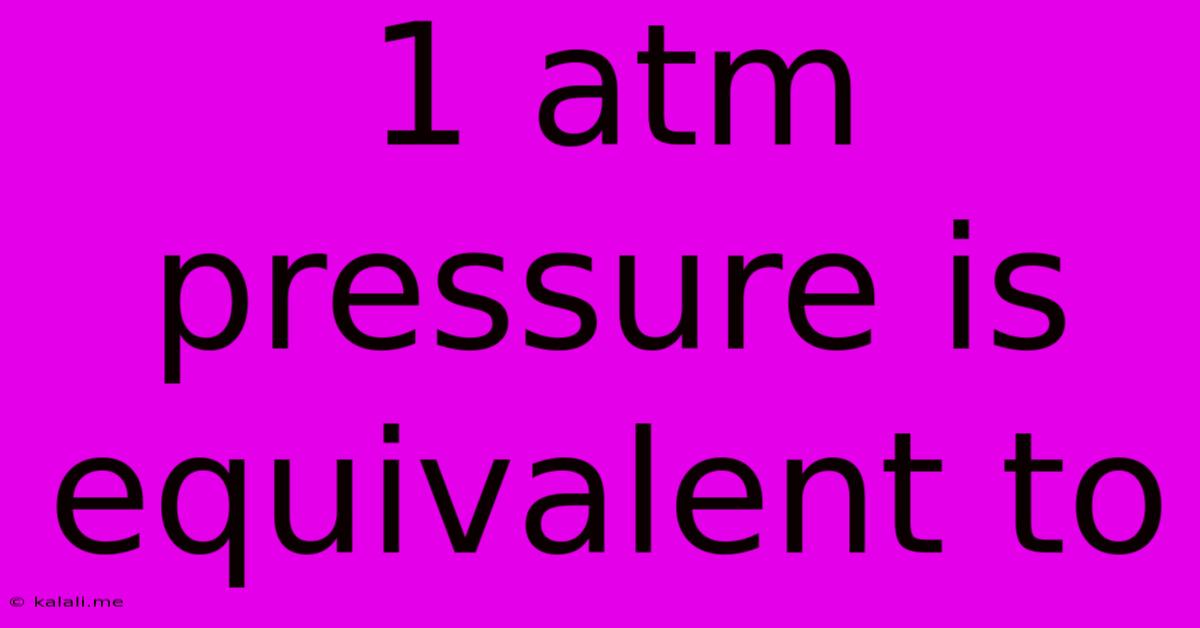1 Atm Pressure Is Equivalent To
Kalali
Jun 13, 2025 · 3 min read

Table of Contents
1 ATM Pressure is Equivalent To: A Comprehensive Guide
One atmosphere (atm) is a unit of pressure, representing the average air pressure at sea level. Understanding what 1 atm is equivalent to is crucial in various fields, from meteorology and aviation to scuba diving and engineering. This article will delve into the various equivalent measurements of 1 atm, exploring their practical applications and providing a clear understanding of this fundamental unit.
What is Atmospheric Pressure?
Before exploring the equivalencies, let's establish a basic understanding. Atmospheric pressure is the force exerted by the weight of the air above a given point. This pressure is constantly changing due to weather patterns, altitude, and temperature variations. Sea level is used as a benchmark, and the average pressure at this level is defined as 1 atmosphere. This pressure is significant because it impacts everything from our breathing to the boiling point of liquids.
1 ATM Pressure: The Equivalencies
1 atm is equivalent to several other units of pressure, each commonly used in different contexts. These include:
-
Pascals (Pa): This is the SI unit of pressure. 1 atm is equivalent to approximately 101,325 Pa. This is often expressed as 101.325 kPa (kilopascals). Pascals are widely used in scientific and engineering applications.
-
Bars (bar): The bar is a slightly larger unit than the atmosphere. 1 atm is approximately equal to 1.01325 bar. Bars are frequently used in meteorology and in high-pressure systems.
-
Millimeters of Mercury (mmHg) or Torr: These units are based on the height of a column of mercury that the atmospheric pressure can support. 1 atm is equivalent to 760 mmHg or 760 torr. This is a traditional unit still used in some medical and scientific contexts.
-
Inches of Mercury (inHg): Similar to mmHg, this unit uses the height of a mercury column. 1 atm equals approximately 29.92 inHg. This unit is often encountered in weather reports in some countries.
-
Pounds per Square Inch (psi): This is a unit commonly used in engineering and industrial applications. 1 atm is equivalent to roughly 14.696 psi. This is particularly relevant when dealing with pneumatic systems and other pressure-based machinery.
-
Atmospheres (atm): While seemingly obvious, it’s important to note that 1 atm is, by definition, 1 atm. This serves as a convenient reference point.
Practical Applications of Understanding 1 ATM
Understanding the various equivalents of 1 atm is crucial in several practical situations:
-
Aviation: Pilots need to understand atmospheric pressure to adjust altimeters and maintain safe flight altitudes.
-
Scuba Diving: Divers must be aware of the pressure changes at different depths to avoid decompression sickness. The pressure increases by approximately 1 atm for every 10 meters of depth.
-
Weather Forecasting: Barometric pressure readings, often expressed in millibars or inches of mercury, are fundamental to weather prediction.
-
Engineering: Engineers use pressure measurements in various designs, including pipelines, pressure vessels, and other systems dealing with fluids under pressure.
-
Medical Applications: Blood pressure is often measured in mmHg, directly relating to the concept of atmospheric pressure.
Conclusion:
1 atm, while seemingly a simple unit, represents a fundamental aspect of our physical world. Understanding its equivalencies in different units is crucial for accurate measurements and calculations across multiple disciplines. From understanding weather patterns to ensuring the safety of divers and pilots, the concept of 1 atm and its numerous equivalents plays a vital role in our daily lives and technological advancements.
Latest Posts
Latest Posts
-
What Year Was I Born In If Im 19
Jul 01, 2025
-
How Many Cups Is 238 Grams Of Miralax Powder
Jul 01, 2025
-
How Much Is Half A Billion Dollars
Jul 01, 2025
-
How Many Days Are In 9 Years
Jul 01, 2025
-
How Much Is 1 8 And 1 8 Teaspoon
Jul 01, 2025
Related Post
Thank you for visiting our website which covers about 1 Atm Pressure Is Equivalent To . We hope the information provided has been useful to you. Feel free to contact us if you have any questions or need further assistance. See you next time and don't miss to bookmark.